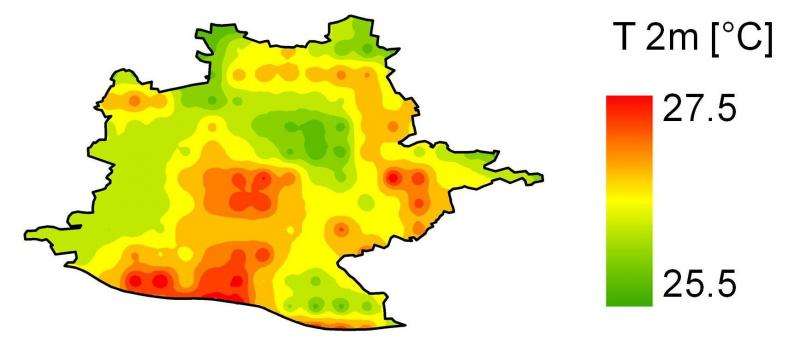Model temperature calculations for the city of Stuttgart. Due to its location in a basin, the city is highly interesting for model calculations of urban climate. Credit: Joachim Fallmann, KIT
Cities represent "heat islands" within their surroundings, which are characterized by many heat sources and small air flows. In southern Europe, bright buildings produce relief and provide for a cooler urban climate. Simulation calculations of KIT researchers for the city of Stuttgart as an example, however, reveal that such measures for enhancing cooling may adversely affect air quality on the ground. The solution of the researchers: Bright facades for cooling and planting of certain types of trees to reduce pollutant concentration.
Scientists of the Atmospheric Environmental Research Division of the Institute of Meteorology and Climate Research (IMK-IFU) of Karlsruhe Institute of Technology (KIT), Garmisch-Partenkirchen, have developed a new simulation strategy that considers both temperature development in cities and transport of pollutants. With the heat wave of 2003 being used as an example, the urban climate of Stuttgart was simulated under various conditions. "Due to its location in a basin, the city of Stuttgart is very interesting for model calculations of urban climate," Joachim Fallmann of IMK-IFU explains. He was involved in the model development.
Fallmann simulated various scenarios, such as enhanced reflection of radiation as a result of a changed color of the buildings in Stuttgart. White-colored houses are traditionally applied to prevent urban heating in the Mediterranean area. Joachim Fallmann explains this effect that is called albedo: "The brighter the buildings and surfaces in a city are, the smaller is the heating rate, because short-wave radiation is reflected and the material is not heated up. This is referred to as a high albedo. Typical grey high-rise buildings, by contrast, have a small albedo and may be considered heat collectors. "The new model approach confirmed that brighter buildings are really suited for counteracting the heat island effect.
As regards air quality, however, this strategy is associated with a surprising drawback: "When it cools down, vertical mixing of the air decreases. Fine dust and pollutants, such as nitrogen oxides, remain closer to the ground and are more concentrated than in a warmer city." Hence, the cooling effect is associated with a serious drawback in particular for the population of cities with strong primary pollution sources, such as industry districts or very dense traffic. For other, so-called secondary pollutants, this effect is positive: "When it is cooler, less ozone is formed, which may be harmful for the respiratory tracts on the ground." Hence, atmosphere chemistry and heat development in a city have to be analyzed together.
Greening of cities is a strategy to compensate the effect of reduced air transport. Trees absorb CO2 and may even bind fine dust on the surface. But according to Joachim Fallmann, the details are of decisive importance again: "The right trees have to be used. Poplars, oak trees, and sycamore trees produce biogenous substances, such as pollen, which may act as precursors of ozone formation." A tree with a positive effect on air quality is the maple tree.
The model of IMK-IFU is an important tool to analyze these complex relationships in detail. In the end, every city has to be analyzed individually according to Joachim Fallmann: "Conditions in Stuttgart differ considerably from those in Munich, where the Alps often supply fresh air. It is our objective to refine the simulation model, such that it can be used to reliably test tailor-made solutions for the different cities."
Provided by Karlsruhe Institute of Technology






















